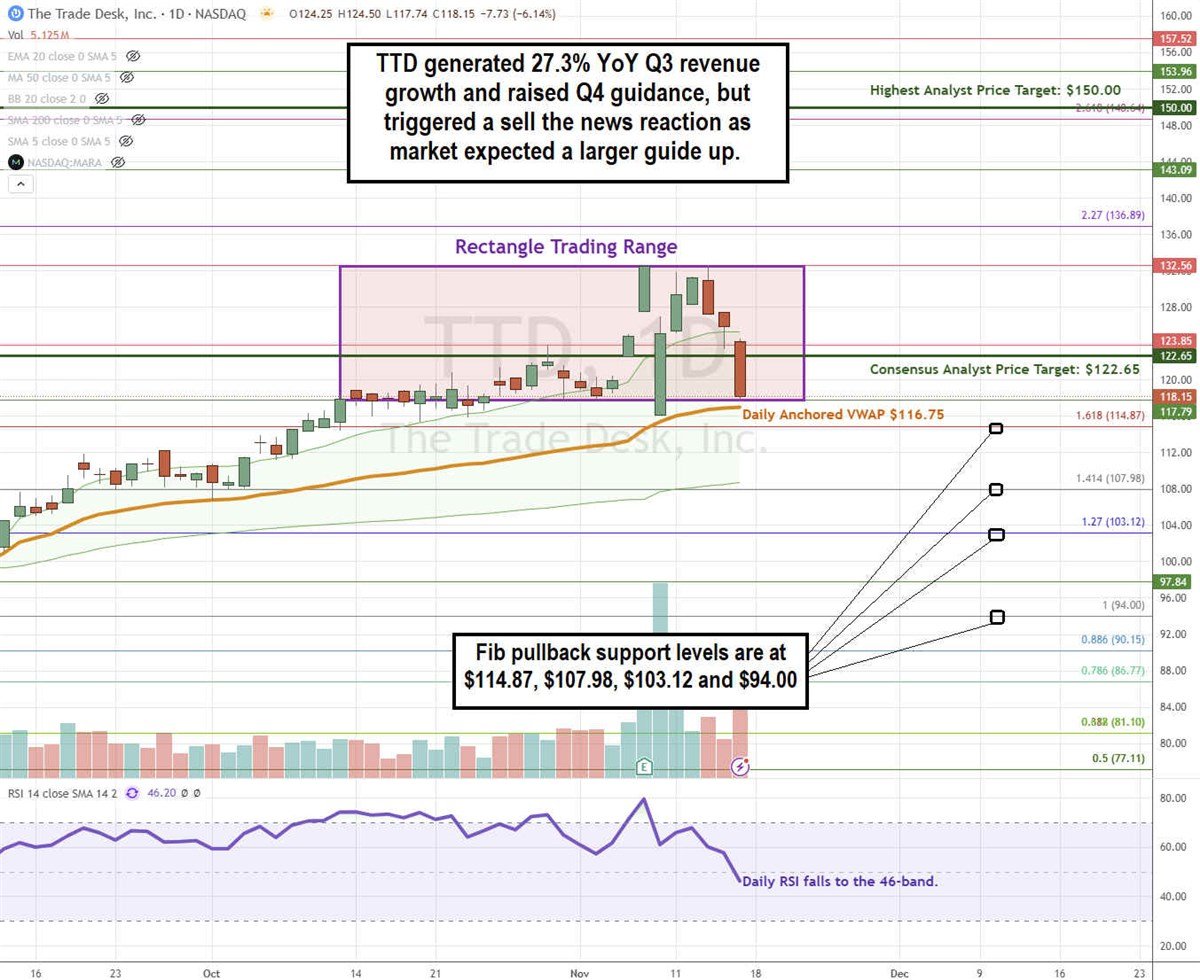
Advertising technology (adtech) giant The Trade Desk Inc. (NASDAQ: TTD) is the leading independent demand-side platform (DSP) for programmatic advertising. The company’s artificial intelligence (AI) powered adtech platform, Kokai, enables brands and marketers to specify and target the exact audience and channels they want to administer their ad spend.
The Trade Desk platform analyzes over 13 million ad opportunities every second to help marketers discover which ones are most effective for their campaigns. The company is on the leading edge of the digital ad revolution and a barometer of the recovery in the ad market.
The shares recently took a tumble on solid third-quarter 2024 performance triggered by a sell-the-news reaction heading into the busiest time of the year for advertising. Bullish investors may consider this a buy-the-dip opportunity.
The computer and technology sector company competes with major adtech platforms like Alphabet Inc. (NASDAQ: GOOGL), Google, Meta Platforms Inc. (NASDAQ: META), and independent sell-side platforms (SSPs) like Magnite Inc. (NASDAQ: MGNI) and PubMatic Inc. (NASDAQ: PUBM) that helps publishers manage and sell their advertising inventory.
Firing on All Pistons, Except One: Guidance
The advertising market has been recovering, and the migration from linear TV advertising to connected TV (CTV) digital advertising has been dramatic. The Trade Desk reported Q3 EPS of 41 cents, beating consensus estimates for 39 cents by 2 cents. Revenues surged 27.3% YoY to $628.02 million, easily beating the $620.16 million consensus estimates. Customer retention remained over 95% in the quarter and the past 10 years. North America generated 88% of total revenue, with 12% generated internationally. International is starting to grow.
The Trade Desk issued upside guidance for Q4, with revenue expected of at least $756 million versus $751.75 million consensus estimates. Adjusted EBITDA is expected to be around $363 million. However, the guidance raise wasn't as big or dramatic as last quarter, which triggered a sell-the-news reaction immediately afterward.
Unified ID 2.0: A Privacy-Safe Answer to Third-Party Tracking Cookies
Privacy issues and Google's move to remove third-party tracking cookies have caused advertisers to seek alternative, noninvasive ad targeting methods. The Trade Desk helped develop Unified ID 2.0, an open-source identity framework designed to track users across digital ad platforms in a privacy-safe manner. It enables advertisers to identify target customers across different devices and platforms and allows them to opt out at any time.
The adoption of Unified ID 2.0 is continuing to spread throughout the advertising industry. Spotify (NYSE: SPOT) extended its partnership with The Trade Desk, piloting integrations of UID2 through Spotify Ad Exchange. Roku Inc. (NASDAQ: ROKU) has come on board with UID2 to enable its advertisers to do more precise targeting in collaboration with Roku Media.
CTV Momentum Continues to Accelerate
The company is optimistic that it will gain significant market share in 2025 as AI is a macro seismic tailwind. Marketers are looking across entire suites of products, features, and algorithms to find out how AI can advance them. The migration to CTV away from linear TV and user-generated content (UGC) to professional ads will continue to accelerate, and retail media has become the fastest-growing area of the business.
The Trade Desk CEO Jeff Green commented, "As we enter our busiest time of year and look ahead to 2025, we have never been in a better position to capture a greater share of the $1 trillion advertising TAM. 2024 has been a banner year for CTV. Many of the largest media companies are now working with us to help clients capture the full value of CTV advertising via programmatic.”
Green concluded, “We are similarly excited about the momentum in retail media and the pace of adoption by advertisers who are taking advantage of our retail data marketplace. The performance improvements that our clients are seeing with Kokai—our largest platform upgrade to date—showcase the value of audience-driven, AI-enabled innovation.”
TTD Stock Forms a Rectangle Trading Range
A rectangle trading range is comprised of a flat-top upper trendline resistance that runs parallel to a flat-bottom lower trendline support. When connecting the two trendlines, a rectangle forms. A breakout occurs when the stock surges up through the upper trendline. A breakdown forms when the stock sinks below the lower trendline.

TTD formed a rectangle trading range comprised of the upper flat-top trendline resistance at $132.56 and flat-bottom lower trendline support at $118.15. The upper trendline resistance was rejected twice, while the lower trendline was able to hold support on multiple tests. The daily anchored VWAP is at $116.75. The daily RSI is falling to the 46-band. Fibonacci (Fib) pullback support levels are at $114.87, $107.98, $103.12 and $94.00.
TTD’s average consensus price target is $122.65, implying a 3.8% upside and its highest analyst price target sits at $150.00. It has 25 analysts' Buy ratings, three Holds, and two Sell Ratings. The stock has a 2.38% short interest.
Actionable Options Strategies: Bullish options investors can buy TTD stock on pullbacks using cash-secured puts at Fib pullback support levels.
The article "The Trade Desk: When Sell the News Turns Into Buy the Dip" first appeared on MarketBeat.







